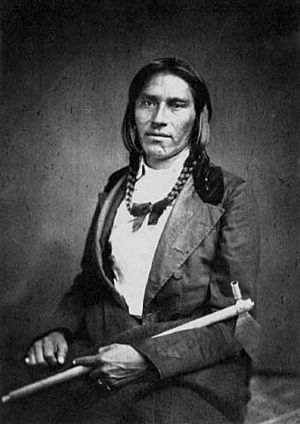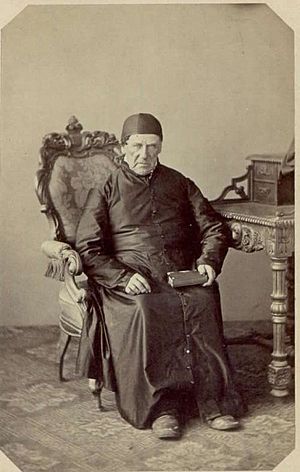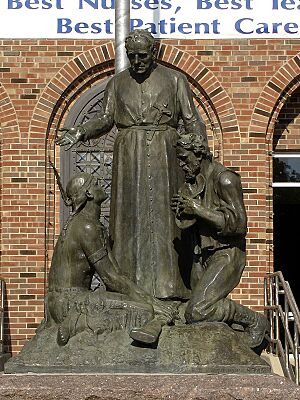Francis Xavier Pierz facts for kids
Francis Xavier Pierz (also known as Slovene: Franc Pirc or German: Franz Pierz) was a Catholic priest and missionary. He lived from November 20, 1785, to January 22, 1880. He worked with the Odawa and Ojibwe Native American tribes in areas that are now Michigan, Wisconsin, Ontario, and Minnesota. Father Pierz encouraged many Catholic German Americans to move and settle in Central Minnesota. Because of his efforts, he is often called the "Father of the Diocese of Saint Cloud."
Contents
Early Life and Work
Father Pierz was born on November 20, 1785, in Godič, a small village near Kamnik in what is now Slovenia. His family were farmers. He began studying to become a priest in 1810 and was ordained on March 13, 1813. Two of his brothers also became priests.
For seven years, he worked as an assistant priest in mountain parishes. Later, he became the main priest for the villages of Peče and Podbrezje. He worked hard to help poor farmers improve their farming methods. In 1830, he even published a book called Kranjski Vertnar (The Carniolan Gardener). His efforts were recognized with a medal in 1842.
Becoming a Missionary
In 1835, Father Pierz was inspired by letters from another Slovenian missionary, Father Frederic Baraga. He decided to become a missionary in the United States. He arrived in the Diocese of Detroit on September 16.
Since Lake Superior had already frozen, he couldn't immediately join Father Baraga. Instead, he was sent to work with the Odawa people in L'Arbre Croche, Michigan. Father Pierz brought his 12-year-old nephew, Joseph Notsch Jr., with him from Slovenia. Joseph helped him on his travels, assisted during Mass, and sometimes cooked.
In the summer of 1836, Father Pierz was moved to the mission in Sault Ste. Marie, Michigan. He worked hard to keep this mission going. He also traveled to other missions around Lake Superior, serving Catholics among the Odawa and Ojibwe people. These tribes spoke Algonquian languages.
Work at Grand Portage
On June 28, 1838, he visited Father Baraga in La Pointe, Wisconsin. Father Baraga convinced him to restart the mission at Grand Portage, Minnesota. This area was once a big center for fur trade, but it had declined. The Ojibwe people there had started commercial fishing and selling their fish.
Father Pierz was very impressed by how eagerly the Ojibwe embraced Catholicism. He preached and taught in the Ojibwe language. He even trained the Grand Portage choir to sing hymns in Ojibwe.
At Grand Portage, Father Pierz also helped clear land for a farm and orchard. This land was owned and worked by the community, following Ojibwe traditions. He helped them sell their extra produce to nearby miners. He also started a Catholic school for the children at the mission. His letters give a clear picture of daily life there.
He also oversaw Catholic missions in Fort William, Ontario and Isle Royale. In October 1839, he was ordered to move to Harbor Springs, Michigan. He stayed there for 12 years.
Serving in Minnesota
In the spring of 1852, Father Pierz moved to the new Diocese of Saint Paul. The bishop, Joseph Crétin, needed priests for his large territory. Father Pierz was given the mission field that covered all of Minnesota Territory north of the Twin Cities.
He set up his main base in the village of Crow Wing. He often walked between his missions, carrying everything he needed for Mass on his back. The Ojibwe people called him "Old Man, Black Gown." They respected him greatly and sometimes even took his socks, believing they had healing powers for rheumatism.
Just like before, Father Pierz continued to preach and teach hymns in the Ojibwe language. People who knew him later recalled that he had a beautiful singing voice when he sang Catholic hymns in Ojibwe.
After the Treaty of Traverse des Sioux in 1851, much of southern and central Minnesota was opened for settlement. Father Pierz saw many Protestant settlers arriving. He began to encourage Catholic German Americans to move to the area. He wrote articles in newspapers like Der Wahrheitsfreund (The Friend of Truth). In these articles, he described Minnesota's great climate, good soil, and free land for settlers.
In May 1855, many German, Luxembourgish, and Slovene settlers began to arrive. They claimed land in what are now Morrison, Benton, and Stearns counties. Since his bishop couldn't fund all his work, Father Pierz got money from European organizations like the Ludwig-Missionsverein and the Leopoldinen-Stiftung. These groups supported Catholic missionaries abroad.
Father Pierz asked Bishop Crétin to send more priests to help him care for both the settlers and the Ojibwe. The bishop contacted Abbot Boniface Wimmer of Saint Vincent Archabbey. On May 21, 1856, five Benedictine priests arrived by steamboat at Sauk Rapids, Minnesota. They founded Saint John's Abbey. Father Pierz left a letter for their leader, formally giving his missions in the area to the Benedictine Order.
The next year, he helped bring Benedictine nuns from Germany to Minnesota. They founded St. Benedict's Convent in St. Joseph, Minnesota. They came to educate the children of the many German immigrants.

In 1857, Father Pierz also invited another Slovenian missionary, Father Lovrenc Lavtižar, to Minnesota. Father Lavtižar was assigned to the Red Lake Indian Reservation. Sadly, on December 3, 1858, Father Lavtižar froze to death during a blizzard. He was returning across the ice of Red Lake after giving the last rites to a dying Ojibwe Catholic. Father Pierz later wrote a poem honoring his friend.
A Peacemaker

During the Dakota War of 1862, Chief Hole in the Day of the Mississippi Band wanted the Ojibwe to join forces with Chief Little Crow and the Dakota people. Their goal was to drive all American and European settlers out of Minnesota. His threats to attack Fort Ripley caused a lot of fear. He also spread a false rumor that the Union Army was forcing Ojibwe men to fight in the American Civil War.
Because of this rumor and Chief Hole in the Day's urging, a group from the Leech Lake Ojibwe burned down the Indian Agency in Walker, Minnesota. They took prisoners and marched to Crow Wing.
However, other Ojibwe chiefs did not agree with going to war against the United States government. Many Ojibwe warriors moved into Fort Ripley to help defend it.
When other peace efforts failed, Father Pierz went into Chief Hole in the Day's camp. He convinced the Chief to travel with him to Crow Wing and sign a peace agreement with the United States government.
In 1863, Father Pierz sailed to Europe to find more priests for the Minnesota missions. Among those who returned with him were Fathers Joseph Francis Buh, Ignaz Tomazin, and James Trobec (who later became the Bishop of Saint Cloud).
After his former teacher, Bishop Frederic Baraga, died on January 19, 1868, Father Pierz wrote another poem to honor him.
On June 27, 1868, Chief Hole in the Day was killed. His son, Ignatius Hole in the Day, who had become Catholic, asked for his father to have a Catholic burial. Since the Chief had considered becoming Catholic but was never baptized, Father Pierz buried him without a special Mass. He was buried in the unconsecrated part of the Catholic cemetery at Old Crow Wing.
According to Ojibwe historian Anton Treuer, Chief Hole in the Day's non-Catholic relatives did not agree with this burial. They secretly reburied him with traditional Ojibwe rituals in a hidden spot near White Earth.
Later Years and Passing
In 1871, Father Pierz, feeling the effects of age, retired to a German parish in Morrison County, Minnesota. This town was later renamed Pierz in his honor. However, his health continued to get worse.
In a letter from January 20, 1872, Father Pierz wrote that his eyesight was failing, and he could no longer read newspapers. He was 87 years old, and his health was declining. He mentioned that two years earlier, he could still manage twelve missions, but now he was urged to retire.
On September 6, 1873, Father Pierz sailed back to Slovenia to live out his final years. He stayed for a while at a Franciscan monastery in his hometown of Kamnik. Then he moved to Ljubljana, where he lived at the Archdiocesan office. The Austro-Hungarian government gave him a full pension.
Father John Seliskar, who knew Father Pierz in his last years, said that Father Pierz's memory was fading. He would often ask a cab driver to take him to places like Wabasha, Minnesota, or other Indian missions in America. A short drive would satisfy him, as he would forget his request. It seemed his mind was still wandering in the American forests.
Father Pierz passed away on January 22, 1880. After a special Mass, he was buried in Saint Christopher's Cemetery in Ljubljana. This cemetery and its churches were later destroyed in 1955 to build a fairground.
As of 1989, the exact location of Father Pierz's remains is not known.
Legacy and Remembrance
Father Pierz is still fondly remembered in both his home country and in central Minnesota. He is a popular figure in Minnesota folklore, with stories about him shared among both the Ojibwe and European-American Catholics in the area.
- The city of Pierz, Minnesota, where he had his last parish assignment before returning to Europe, is named after him.
- A bronze statue of Father Pierz was put up in front of St. Cloud Hospital in 1952. It showed an Ojibwe warrior and a German-American settler kneeling before him, celebrating his role as a missionary and peacemaker. However, in the early 21st century, the statue was moved after protests by the St. Cloud chapter of the American Indian Movement. It was then placed in nearby Pierz, Minnesota.
- In Slovenia, a bronze monument to him was built in Podbrezje, his last parish before he went to the US.
- A large collection of his letters and poems are kept in the Archives of the Republic of Slovenia in Ljubljana.
- The Slovene Ethnographic Museum in Ljubljana has many rare Native American artifacts that Father Pierz collected and donated.
- The St. Francis Xavier Catholic school in Sartell, Minnesota is also named in his honor.




